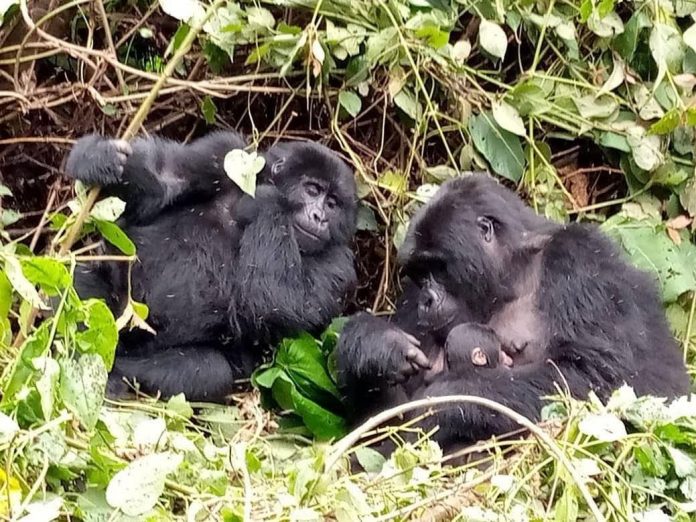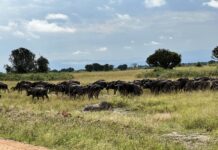September 24th, 2022 is World Gorilla Day. As the world celebrates this day, we take some time to take note of why this wonderful great ape is celebrated.
It is important to note that there are only about 1,200 individuals of mountain gorillas remaining in the whole world hence its international recognition as an endangered species.
The habitat of these mountain gorillas is limited to Uganda, Rwanda, and the Democratic Republic of Congo. Uganda is noted to have 2 national parks where mountain gorillas are found namely; Bwindi Impenetrable National Park and Mgahinga Gorilla National Park.
Mgahinga Gorilla National Park in Uganda is in the Virunga Conservation Area that is shared by Parc National des Volcans of Rwanda and Virunga National Park of the Democratic Republic of Congo. Bwindi Impenetrable National Park in Uganda is the other stand-alone park where mountain gorillas are found.
There is no record of the mountain gorillas in any captivity in the world. Meaning the only way anyone is able to view these mountain gorillas is by going to their natural habitat where habituated groups are available for visitor viewing.
The mountain gorillas live in high-altitude montane and bamboo forests hence, people with altitude issues are highly advised against taking the step to go and visit the mountain gorillas.
These gentle giants are often referred to as man’s closest relatives simply because we share about 98% DNA with the mountain gorillas. With this fact, the sicknesses that we as humans face can as well attack these mountain gorillas.
Even with the recent Covid 19 pandemic, visits to these beautiful creatures were limited by the respective governments. Even to date, before going for gorilla tracking in Rwanda, you are supposed to present a negative PCR test result to be granted permission.
Before gorilla tracking, visitors are taken through a briefing where they are advised on the dos and don’ts when they encounter the mountain gorillas. At the time of the briefing, people with common colds and other illnesses are advised to stay behind so as not to transmit those illnesses to the mountain gorillas.
A high degree of fitness is required for anyone wanting to track these gorillas because movement is in dense forest cover where there are no clear paths and encounters undergrowth in valleys and hills while in the forest. Porters come in handy while on the trek because they help carry your luggage and oftentimes also help pull or push you when the going gets tough. Hiring a porter is one way of contributing to the community’s well-being since that payment acts as a salary for the porters who work on a rotational basis.
The mountain gorillas are often referred to as the great apes or the gentle giants simply because they are the most powerful and largest of all the apes. A female mountain gorilla can weigh up to 90Kgs while an average silverback gorilla can weigh twice the size of the female mountain gorilla which is up to about 180Kgs.
The mountain gorillas sleep in nests which are made at night. These nests are made either in the trees or on the ground. Normally, infants will sleep in the same nest occupied by their mothers. The mountain gorilla nests are made from foliage.
Just like humans, gorillas live in groups or families. The family is headed by a dominant male which is normally a silverback with many females. There is limited inbreeding in gorilla families and this is evident by the fact that most males and females will leave the group to join another family when they get older.
Mountain gorillas are known to live up to over 40 years in the wild. The age of these creatures is used to class them for instance; infants from birth to about 3 and a half years, from three and a half years to 8 years are teenagers, from 8 years and above are adults. For the males, 8 to 12 years are blackbacks, who attain silverback status from 12 years. The silverback earns its name after developing silver hair on their backs and on their hips.
It is important to note that these mountain gorillas are a threatened species. The major threat to the mountain gorillas is the human being. Since the gorillas and humans share 98% DNA, there is competition for food, as well as habitat. The mountain gorillas live in forest and with the ever-increasing population of people around these forests, there is pressure inserted on the forest cover in order to create space for housing and farmland for the humans.
Some times the gorillas invade human gardens for food crops especially the maize and the bananas. This often breeds conflicts between the authorities responsible for the gorillas and communities surrounding the gorilla habitat.
One of the gorilla doctors, Dr. Gladys Kalema – Zikusoka mentioned “we must do everything we can to ensure all gorillas have a future with us on the planet.” She has been spearheading the conservation program promoting the protection of the mountain gorillas with one sip at a time. The initiative encourages the population around Bwindi to grow coffee which is in turn purchased from them and then, they make the Kanyonyi Coffee Blend. The communities are able to earn an income from the coffee sold hence boosting their livelihoods.
As we celebrate the World Gorilla Day, it is important to note that Gorilla Tourism is the major tourism earner in Uganda, and Rwanda accounting for over 90% of the foreign tourists in Uganda and Rwanda. It is right to mention that almost every tourist who comes to visit Uganda’s protected areas is here for the gorillas and the other destinations are only the icing on the cake. With this fact, the respective governments have made important strides towards gorilla conservation. For instance, of the gorilla permit fee paid in Uganda 10% is sent back to Bwindi and Mgahinga for community development projects.






